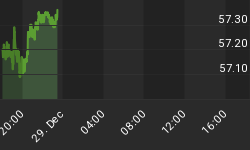The following is part of Pivotal Events that was published for our subscribers August 4, 2016.
Signs of The Times
"Silicon Valley Elites Get Home Loans with No Money Down"
- Bloomberg, July 27.
"In Hamptons, The Rich and Those Who Serve Them See Two Elections"
"Stars of Wall Street and Hollywood who enjoy the beaches, hedge-rowed estates and $100,000-a-month rentals talk about income equity. Residents who supply the seaplane set with everything from lobster to massages rail against over-regulation and worry about the country's direction."
- Bloomberg, August 1.
"If You Disagree With This Harvard Economist You May Be Stupid and a Racist"
"Isolationist, nationalist, ethnocentric worldview is related to one's level of education."
"The more years of schooling people have, the more likely they are to reject anti-globalization attitudes."
- Zero Hedge, July 31.
The smug author of this elitist stuff is Greg Mankiw, who in December 2007 boasted that nothing could go wrong. The Fed had a "dream team" of economists. The worst recession since the 1930s began in December 2007. The greatest credit contraction in history had begun when the curve and spreads reversed in that fateful May- June.
The theory was that the boom could be kept going by a wisely-timed cut in administered rates. Yet again, we published an article documenting that interest rates go up with a boom and down with the bust. Elitist theories seem based more upon intuition than empirical evidence. Not to overlook the control-freak compulsion to force personal superstitions upon someone else.
Maybe it is an elitist thing to live in a land of unreal theories. The problem is that they have had the power to impose impractical theories upon the rest of society.
In the real world, when an idea is seen not to work it is discarded.
In the increasingly unreal world of policymaking the more obvious the failure, the more it is pushed. The Bank of Japan has been aggressively easing credit since 1990. It is possible that some staffers today weren't even born when the madness started. And it never seems enough to satisfy arbitrary ambition.
The next contraction should provide the evidence needed to throw out impractical interventionist theories.
It will take formidable political will to effect practical change.
And then there is comic relief:
"Japan's Top Credit Analyst Predicts 30Y Treasury Yield Plunging to Zero in 2 Years"
- Zero Hedge, August 3.
This story has been "in the market" for more than a year.
Commodities
The decline in crude oil fell into the Sequential Buy Pattern, which concluded earlier in the week. Also, as Ross pointed out it was declining into support. The market seems to be turning and it could retrace around half of the recent loss. That works out to 45.50, or there-a-bouts.
The turn was being helped by the weakening dollar, which could continue flat to down through August.
For most commodities, we have been looking for a trading range through August, and perhaps into September. Often crude can set a seasonal high around late September.
However, as pointed out a few weeks ago breaking below 41 would be significant. The low was 39.26 on Tuesday.
Most commodities started the August trading range at support. The DBC declined to the 200-Day ma at 13.96 on Tuesday and has recovered to 14.21.
Base metals (GYX) tested support at 271 a couple of weeks ago and are at 277. The last high was 283 and getting beyond that level the swing could reach 300.
Grains (GKX) soared to 339 in early June and slumped to 281 on Tuesday. This was down to 30 on the Daily RSI and at support. Firming for some weeks is possible. There is resistance at the 293 level.
Since March, lumber's advance has had corrections limited by the rising 50-Day ma. The high at 338 a couple of weeks ago was at resistance. And, again, the correction was to the
50-Day, this time at 313 on Monday. There is resistance from 338 to 342 and we still think a cyclical peak is building.
This year's "Rotation" in iron ore was outstanding. That's in the price gain as well as in its technical peak. The low was 31 in January and the high was 60.58 in April, which generated a Sequential (9) Sell. The price fell to 42 at the end of May.
The next zoom made it to 58.65 on Monday.
This was with enough thrust to register a Sequential Sell on both the 9-week and 13-week determinations. This should be effective within a week.
We can't help but wonder if iron ore and copper have been again leveraged in the financial engineering game that was the sensation in 2015. As Shanghai was blowing out.
Once rolled, the target becomes the low at 42. After all, iron is the most common element, not the most precious.
Small Cap Valuation Goes Sky High

Source: Zero Hedge
- "Normal" is around 11.
- Now at 21.
- Latest rally is testing the December high.
- What could drive it higher?
- What could go wrong?
GDP: Rate of Change and Recessions

- Note the "best" level reached in June 2007.
- Also note the jump as crude oil and credit spreads came off of their best in June 2014.
U.S. Leveraged Loan Default Rate Since 2003

Debt to EBITDA Ratios

- The two previous sharp increases occurred in severe contractions.
- Perhaps an involuntary plunge in earnings.
- The huge rise since 2011 seems to be during the "good times".
- Could be driven by an inordinate increase in debt.
- While voluntary, it may soon be regrettable.
Link to August 6 Bob Hoye interview on TalkDigitalNetwork.com: http://www.howestreet.com/2016/08/05/better-us-employment-drops-gold-price/
Listen to the Bob Hoye Podcast every Friday afternoon at TalkDigitalNetwork.com
















